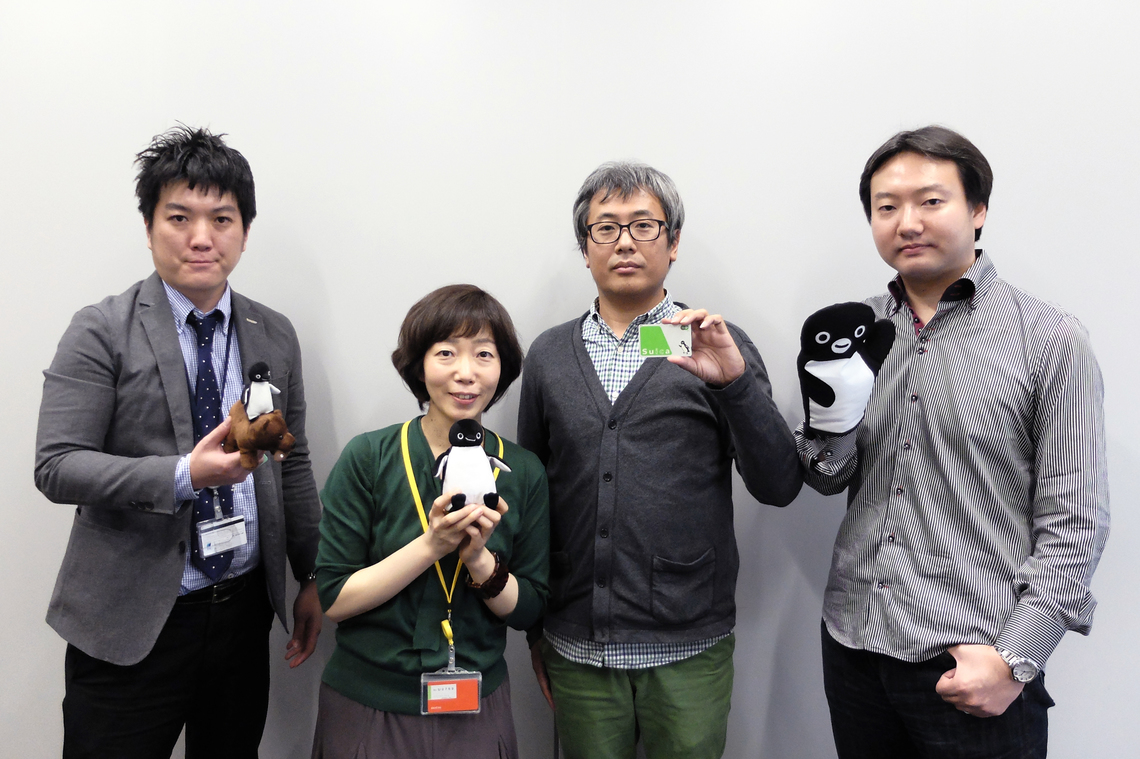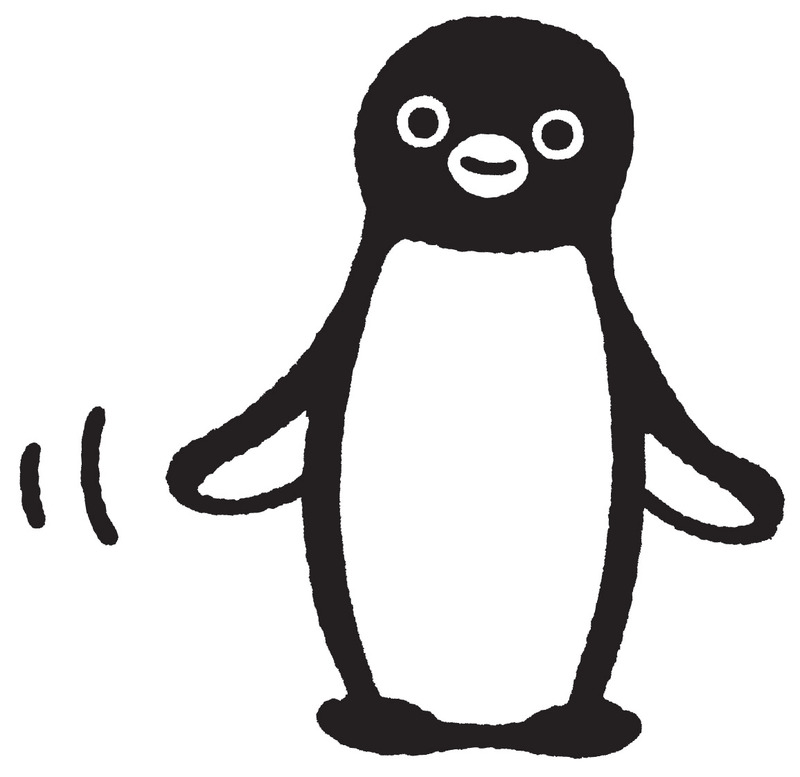JR East's corporate mascot, "Suica Penguin." We invite original creator and picture book author Chiharu Sakazaki, Art Director Tomotomo Tanaka, and Licensing Manager Hideki Kuribayashi to reveal the secrets behind corporate communication using "Suica Penguin" in this second part. ※Part 1 is available here.

Beloved Design · Functional Design
Yamamoto: First, I'd like to ask about the design process. I've always noticed the distinctive, subtle undulations in the penguin's body lines.
Sakazaki: Yes. Of course, we could have made it smooth, but personally, I prefer lines that show a bit of the artist's touch. The hand-drawn imperfections add character, you could say.

Tanaka: And that wiggle is really effective. It makes it look incredibly soft and approachable. You can tell it wasn't just quickly done on a Mac; you can feel the time spent drawing it, the layers built up. This definitely anchors the Suica Penguin, successfully conveying that impression of traditional art.
Yamamoto: So creating that atmosphere from the details is part of what gives it quality and makes it endearing. Regarding color, you might initially think a black character is hard to make stand out as an eye-catcher. But with the world so saturated with color, maybe this simplicity is actually what makes it stand out?
Tanaka: They stand out. Black and white have the strongest contrast in brightness. Plus, not having color is actually a huge help—it makes it much easier to incorporate the client's corporate colors or service colors, which are absolutely essential for branding, right? So, monochrome is actually easier to work with.
The Close Relationship Between Advertising and Merchandise
Kuribayashi: Following that creative philosophy, we struggled early on with merchandise—we could only use black, white, and JR's corporate green. Just three colors! (laughs)
Yamamoto: Oh, now we're getting to the unique struggles of the merchandising license manager (laughs). Another major strength of the Suica Penguin is how consistently unified the tone and manner are across every item – from promotional giveaways to retail merchandise. I don't think many corporate characters have their branding executed this thoroughly across all goods.
Tanaka: As Kuribayashi-kun mentioned earlier, regarding merchandise development, we initially disliked inconsistent designs. For a long time, we strictly limited colors to the penguin's black and white, plus Suica's key green, and allowed only three types of illustrations.
Kuribayashi: Around the time we entered our 10th year, we entered a phase of expansion, significantly increasing both the available colors and design options.
Tanaka: I believe that by setting strict standards early on, we fostered a shared awareness of quality among staff, including clients, about what "we shouldn't do." This is why the brand remains consistent even as the merchandise lineup has expanded.
Yamamoto: Mr. Sakazaki, is there any particular merchandise item you have a special attachment to?
Sakazaki: I get all sorts of requests, but personally, I was really happy about the playing cards. But every once in a while, there's something like... well, that makes Kuribayashi and I scratch our heads (laughs).

Tanaka: With characters, there are parts you evolve and parts you keep unchanged. For example, if the form stays exactly the same every time, people get bored, so you tweak it slightly. That applies to merchandise sales too. Even looking at promotional calendars, you can sense subtle changes. Is that intentional on your part, Mr. Sakazaki?
Sakazaki: Naturally, we're influenced by trends in the world and the intent behind advertising campaigns. For instance, the penguins' bodies are becoming rounder and cuter. Especially when they're turned into merchandise, they inevitably get rounder. So, I consciously try to keep them from becoming too childish. Lately, I've been paying attention to that and trying to make their bodies a bit longer.
Yamamoto: We're seeing this expansion where client group companies are also creating merchandise, boosting the Suica Penguin across the entire group. The penguin rooms in hotels are one example, and the penguin ekiben (station bento) became a hot topic online. Corporate characters often end up confined to advertising, so it's rare for one to have this kind of business expansion.

Kuribayashi: Regarding our approach to merchandising, we believe merchandise can also update the brand story. Even when commercials aren't airing constantly, we consciously aim to show the world, through goods, that this penguin is always evolving.
Yamamoto: The Suica Penguin's approach—where advertising communication and licensed products integrate to expand its world—might become a benchmark for future corporate character communication.
The Suica Penguin's Vision
Kuribayashi: With the declining birthrate, character merchandise sections are shrinking in retail stores, and manufacturers are increasingly focusing only on content that sells. Amidst this, Suica Penguin benefits from constant exposure at stations and stable merchandise distribution channels.
Tanaka: There's a dedicated merchandise store called "Pensta" inside Tokyo Station. While naming it "Penguin Shop" might have sufficed, they deliberately chose a stadium-like name. A stadium evokes an impression of potential for diverse expansion, right? Not just targeting salarymen and office ladies, but also children with something like a "Pensta Kids Museum." I feel like this penguin's worldview, created by Mr. Sakazaki, could make that happen. Just a creator's wild imagination, though (laughs).
Sakazaki: Nothing would make me happier than seeing penguins loved by even more generations.
Tanaka: There aren't that many "corporate characters" that are loved for so long and by such a wide audience, right? This growth is because the penguin continues to be cherished by so many different clients. From our senior creators like dof's Oshima ECD and Kotoba's Yamamoto CD, to the junior creator team constantly building the world, and the AE team obsessively focused on how the penguin appears – the production team is excessively sincere about the penguin (laughs), and I think that really makes a difference. It's a rare, great team.
Kuribayashi: I inherited this from our seniors, and I believe the current situation is also thanks to the ongoing understanding and cooperation from our company's sales division. I also feel the incredible passion from our clients and the representatives at each company involved in product development (laughs).
Yamamoto: It's an incredible energy (laughs). I'm really looking forward to seeing how the penguin evolves from the picture book to a corporate character and beyond. Thank you very much.













